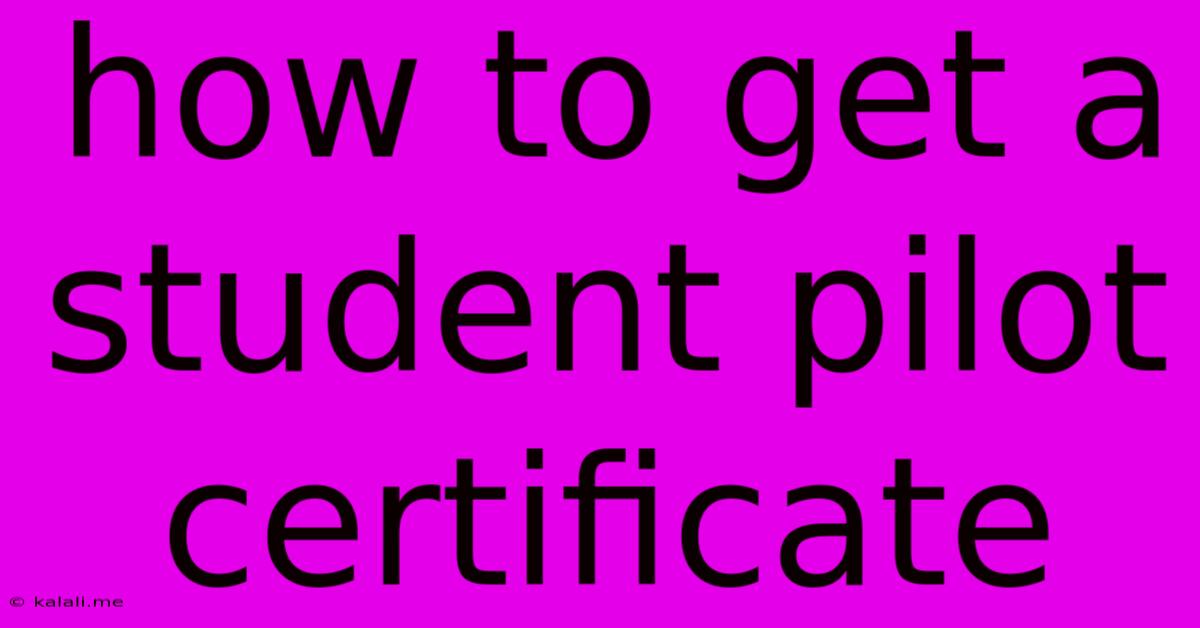How To Get A Student Pilot Certificate
Kalali
Jun 05, 2025 · 4 min read

Table of Contents
How to Get a Student Pilot Certificate: Your Journey to the Skies Begins
So, you're dreaming of soaring through the clouds, feeling the wind beneath your wings, and experiencing the freedom of flight? Getting your Student Pilot Certificate (SPC) is the first crucial step in making that dream a reality. This comprehensive guide will walk you through the process, from initial requirements to the final exam, ensuring you're well-prepared for your journey into aviation. This guide covers everything you need to know about obtaining a student pilot certificate, including medical certificates, flight training, and written exams.
Understanding the Student Pilot Certificate
The Student Pilot Certificate isn't a license allowing you to fly solo. Instead, it's your official permission to begin flight training under the supervision of a certified flight instructor (CFI). It's the foundational stepping stone towards obtaining your Private Pilot License (PPL), the license that allows you to fly solo and carry passengers. Think of it as your "learner's permit" for flying.
Step 1: Meeting the Requirements
Before you even think about your first flight lesson, you need to meet several prerequisites:
- Age: You must be at least 16 years old for a student pilot certificate. The minimum age for a private pilot license is 17.
- Medical Certificate: You'll need a medical certificate issued by an Aviation Medical Examiner (AME). The class of medical certificate required depends on the type of flying you intend to do. It's best to get this done early in the process as it can sometimes take time.
- Read, Speak, and Understand English: Fluency in English is a mandatory requirement.
- Knowledge of the Regulations: While you’ll learn more during ground school, a basic understanding of aviation regulations is helpful.
Step 2: Finding a Flight School and Instructor
Choosing the right flight school and instructor is paramount. Look for:
- Reputation: Research different schools and read reviews. Look for consistency in positive feedback.
- Certified Flight Instructors (CFIs): Ensure the instructors are certified and experienced.
- Aircraft Availability: Check the availability of aircraft suitable for your training.
- Cost and Payment Options: Understand the pricing structure and payment plans.
Step 3: Ground School Training
Ground school is essential. This classroom or online instruction covers:
- Aviation Regulations (FARs): Understanding these rules is crucial for safe flying.
- Meteorology: Learning about weather patterns is vital for flight planning and safety.
- Navigation: You'll learn how to navigate using various methods, including charts and instruments.
- Aircraft Systems: Understanding how the aircraft works is essential for safe operation.
- Aerodynamics: This involves understanding the forces that act on an aircraft in flight.
Many flight schools offer integrated ground school programs. This is usually a more efficient way to complete your ground training.
Step 4: Flight Training
This is where the fun begins! Your CFI will guide you through:
- Pre-flight Inspection: Learning how to thoroughly inspect your aircraft before each flight is a critical safety procedure.
- Taxiing and Takeoff: Mastering these fundamental maneuvers are essential.
- Basic Flight Maneuvers: This includes climbs, descents, turns, and stalls.
- Navigation: You’ll practice navigation techniques learned in ground school.
- Emergency Procedures: Learning how to handle unexpected situations is paramount.
Step 5: Written Exam
Once you've completed your ground school, you'll take a written exam covering all aspects of the knowledge learned. This exam tests your understanding of regulations, meteorology, navigation, and aircraft systems. Preparation is key; utilize practice exams and study materials provided by your flight school.
Step 6: Checkride (Practical Exam)
After successfully passing your written exam, you'll schedule your checkride with a Designated Pilot Examiner (DPE). The checkride assesses your flight skills and knowledge. It will cover:
- Oral Exam: A thorough oral examination tests your understanding of aviation regulations and procedures.
- Flight Exam: Demonstrates your proficiency in basic flight maneuvers and emergency procedures.
Step 7: Obtaining Your Student Pilot Certificate
Upon successful completion of your written exam and checkride, you will officially receive your Student Pilot Certificate! This allows you to continue your flight training towards your Private Pilot License.
This is your starting point; remember that dedication, consistent practice, and a passion for aviation will help you achieve your dreams. Safe flying!
Latest Posts
Latest Posts
-
Can I Put Vanilla Extract In My Coffee
Jun 06, 2025
-
Hoses Are Used When Movement Occurs Between Two Parts
Jun 06, 2025
-
How To Dry Clothes Without A Dryer
Jun 06, 2025
-
Will We Be Male Or Female In Heaven
Jun 06, 2025
-
Is A Shove An Attack 5e Extra Attack
Jun 06, 2025
Related Post
Thank you for visiting our website which covers about How To Get A Student Pilot Certificate . We hope the information provided has been useful to you. Feel free to contact us if you have any questions or need further assistance. See you next time and don't miss to bookmark.